In 1995, in recognition of Tennessee’s unique natural heritage, the state legislature designated the Tennessee cave salamander as our official State Amphibian. You may be wondering, “What are salamanders and why are they important?” Salamanders are the group of animals, including newts, sirens and amphiumas, that have smooth, moist, porous skin, lay jelly-like eggs and have a long tail. Often they are mistakenly referred to as “spring lizards,” when in fact they belong to the group of animals known as amphibians. Unlike lizards, a type of reptile, salamanders lack scales on the body, do not have claws on the toes, and cannot survive far from moisture.
Salamanders are nocturnal and come out from their hiding places during moist nights to hunt for prey. Most species eat large amounts of invertebrates such as worms, insects and snails. A few species, like spring and red salamanders, will even eat other salamanders. Salamanders are equally important as food for many other animals, such as raccoons, opossums, bears, mink, river otter, frogs and snakes. In some places they are the most abundant vertebrate animals in the forest. They are also important as biological indicators as their porous skin is sensitive to environmental toxins. Since many live in both aquatic and terrestrial habitats, scientists use them to monitor for problems in the environment.
Most of Tennessee's salamanders have a biphasic life cycle, meaning they spend part of their life in a tadpole-like larval stage then morph into the adult stage. Many species of salamanders spend their adult stage on land in moist habitats near water. Then during the breeding period, the adult salamanders move into the breeding ponds to court and lay eggs. Spotted salamanders are well known for their mass migrations in the spring as they move from their forest habitat to their breeding ponds. Salamanders require ponds that have no fish in them as “Fish Eat Amphibians!” Temporary ditches, road ruts, flooded fields, wet depressions and semi-permanent to permanent ponds are all favorable breeding habitat. A few species, like the pigmy salamander and seepage salamander, skip the larval stage and the eggs hatch into perfect miniatures of the adults. While most salamanders lay their eggs and then depart, some species like the green and marbled salamanders stay and guard their eggs to help protect them from small predators and fungus.
What are some of the major challenges facing salamanders today? As more and more people use more resources and require more places to live, habitat destruction and modification are occurring at an alarming rate and are the greatest threats facing salamanders. Another major problem salamanders face is habitat fragmentation; salamanders are unable to move freely between populations or even reach their breeding ponds because of highways and other construction. Introduced species can negatively affect salamanders by direct predation and competition. Chemicals such as pesticides, herbicides, and fertilizers are adversely affecting salamanders in many areas around the world. Other factors that may negatively affect salamanders in Tennessee are climate change, disease and collection for the pet trade even though it is illegal to remove any native animal from the wild in Tennessee.
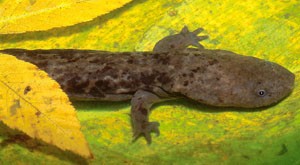
Photo ©Suzanne Collins, Center for North American Herpetology
HELLBENDER
Cryptobranchus alleganiensis
Family: Cryptobranchidae
Tennessee’s largest salamander (30-74 cm), the hellbender is an aquatic species that inhabits clean, fast flowing streams and rivers, where large flat rocks provide plenty of cover. Small eyes in a large flattened head, slimy skin secretions and loose folds of skin along the sides of the body contribute to the bizarre look of this salamander. Hellbenders are nocturnal and search at night for small fish and crayfish. Occasionally they are caught by fishermen using baited hooks. A harmless species, this once abundant salamander has declined throughout much of its range due to impoundments and pollution. It occurs sporadically throughout the eastern two-thirds of Tennessee and is currently listed by the State of Tennessee as being “In Need of Management.”
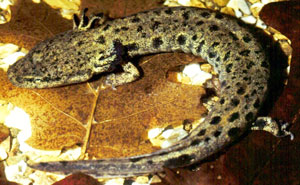
Photo ©Suzanne Collins, Center for North American Herpetology
MUDPUPPY
Necturus maculosus
Family: Proteidae
The mudpuppy is an aquatic salamander that inhabits large streams with fast-flowing water and rocky bottoms, and also reservoirs. They reside beneath logs and rocks during the day and emerge to feed at night. They are fairly large (20 – 49 cm) and have dark red, bushy gills their entire life. A dark line extends through the eye to the gills and the brown, rusty brown, gray or black body has large dark bluish-black to black splotches. The underbelly is whitish to gray and may also be spotted. It also has a very snubbed nose. Mudpuppies prey upon a large variety of creatures including crayfish, insects, mollusks, fish and amphibians. The mudpuppy is found throughout Tennessee except for the northwestern corner of the state.
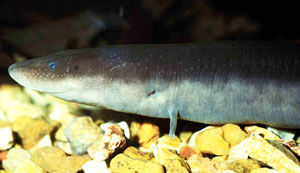
Photo ©Suzanne Collins, Center for North American Herpetology
THREE-TOED AMPHIUMA
Amphiuma tridactylum
Family: Amphiumidae
The three-toed amphiuma, sometimes referred to as a Congo eel, is a large aquatic salamander that lives in semi-permanent to permanent bodies of water with abundant vegetation. Drainage ditches, sloughs, backwater and swamps are all favorite habitat. Adults are bi-colored, with a black, slate or brownish back and a lighter gray belly. The four limbs are extremely thin and elongated and each foot has three toes. The tail is laterally compressed to aid in swimming. There are no external gills. The three-toed amphiuma averages from 46 to 106 cm. This large salamander feeds upon crayfish, earthworms, fish, terrestrial and aquatic insects, spiders, snails, skinks and a small amount of vegetation. They may emerge from their burrows at night to forage, especially during heavy rains. Amphiumas are found only in the western part of the state in the Mississippi Alluvial Floodplain.

Photo ©John White
LESSER SIREN
Siren intermedia
Family: Sirenidae
This eel-like aquatic salamander lacks hind legs, has an elongated body (18 – 69 cm), branching gills and a dorsal fin extending from the vent to the tail tip. They are olive-green, grayish-blue or black, often with scattered brown or black spots on the back and may have white to yellowish flecks on the sides. They live in semi-permanent to permanent bodies of water, particularly floodplain pools, marshes, swamps, sloughs, backwaters, ditches, vegetation-choked sluggish creeks and occasionally farm ponds. They feed upon algae, particularly filamentous species, vascular plants, invertebrates and the eggs of amphibians, even other siren eggs. They are found in the northwestern and southwestern corners of Tennessee, although further research is needed to determine the full range, life history and conservation needs of the lesser siren in Tennessee.
Not Pictured
STREAMSIDE SALAMANDER
Ambystoma barbouri
Family: Ambystomatidae
Closely related to the small-mouthed salamander, Ambystoma texanum, the streamside salamander is usually a brownish-gray to grayish black with numerous small, light gray speckles that sometimes merge on the sides to form a lichen-like pattern. A medium-sized salamander (11 – 19 cm), it has a stocky body and a small head. The streamside salamander is found in sporadic populations throughout Middle Tennessee, primarily in limestone habitats.
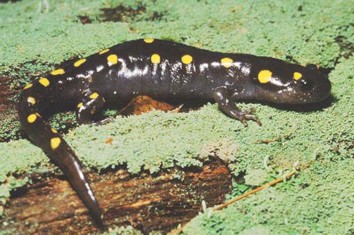
Photo ©Twan Leenders
SPOTTED SALAMANDER
Ambystoma maculatum
Family: Ambystomatidae
Found statewide in Tennessee, this large (15 – 25 cm) attractive salamander has a dark purplish-black, steel gray or black body. There are two irregular rows of bright yellow to yellowish-orange spots starting on the head and extending down the back to the tip of the tail. These salamanders migrate in large masses in the spring to breeding ponds during the first warm spring rains and on foggy nights when moisture is high. They breed in fish-free vernal ponds, swamps, roadside ditches and flooded tire ruts; they may also breed in permanent ponds where no fish have been introduced. Throughout the rest of the year they live in bottomland forests, floodplains, upland forests and mature deciduous woods containing vernal ponds.
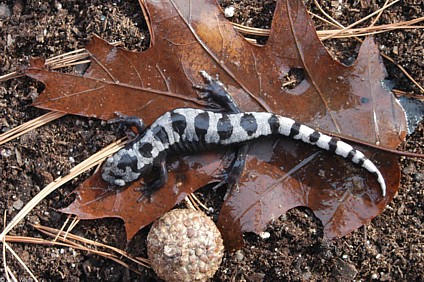
Photo ©John White
MARBLED SALAMANDER
Ambystoma opacum
Family: Ambystomatidae
The marbled salamander looks like it just came out of the chrome plating shop with its metallic silvery-white to gray bands on the dorsum of its black body. A medium sized (11.2 – 19.7 cm), stout bodied salamander, males and females can be told apart by the color of their crossbands; males have silvery-white bands, while females have gray bands. This salamander is the only member of its family in Tennessee to mate and lay eggs upon land. Females construct nests just below the leaf litter of dried beds of temporary or drying ponds in the fall. Females will often stay to protect the eggs from small predators and fungus. Eggs hatch when the nest is flooded during winter or early spring rains.

Photo ©John White
MOLE SALAMANDER
Ambystoma talpoideum
Family: Ambystomatidae
Mole salamanders are one of the few salamanders in Tennessee that may exist either as terrestrial adults or as aquatic, gilled, breeding larva (neoteny). These salamanders have a short, stocky body (8 – 12 cm), rounded head, short tail and short, stocky legs. They may vary in color from light gray to light brown, dark gray or black; light gray specks upon the back and sides may be unnoticeable in many specimens. The juveniles and adults of this species have a special gland (the parotoid gland) that produces a noxious secretion. Adults breed in temporary to permanent bodies of water that do not have fish. Terrestrial adults of this species are most often found within floodplain forests, or in upland forests close to breeding sites. This species is found throughout the western third of the state, with scattered populations found throughout the rest of the state.
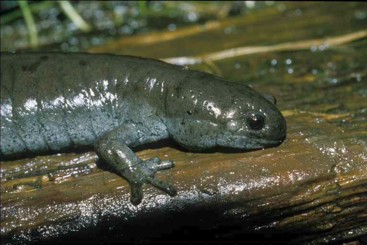
Photo ©Henk Wallays
SMALL-MOUTHED SALAMANDER
Ambystoma texanum
Family: Ambystomatidae
Closely related to the streamside salamander, Ambystoma barbouri, these salamanders are usually a brownish-gray to grayish black with numerous small, light gray speckles that sometimes merge on the sides to form a lichen-like pattern. It is a medium-sized salamander (11 – 19 cm) with a stocky body and a small head. The small-mouthed salamander is found mainly in bottomland forests associated with wetlands or floodplains; the streamside salamander prefers upland deciduous forests with rolling hills, but may also inhabit streams.

Photo ©Lisa Powers, Froghaven Farm
TIGER SALAMANDER
Ambystoma tigrinum
Family: Ambystomatidae
Our largest terrestrial salamander, the tiger salamander may range from 18 to 35 cm in length. It has a large stocky body with stocky limbs and a broad head. The color and pattern of the tiger salamander is extremely variable but consists of yellow, greenish, brown or bronzy spots or striations on a base color of dark brown or grayish-black. As larva, this species exhibits two morphs (phases), a typical and a cannibalistic form. The cannibalistic form has modifications of the head and teeth and is typically larger than the typical form. Tiger salamanders breed in late fall through spring in semi-permanent bodies of water and permanent, fishless ponds. Adults live in burrows in the soil that they often dig themselves. The distribution of this salamander is somewhat sporadic in middle and eastern Tennessee, but more studies are needed to determine the true range of this species in the state.
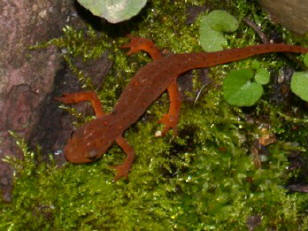
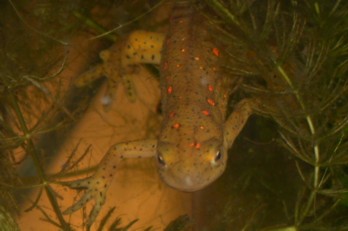
Photos ©Lisa Powers, Froghaven Farm
EASTERN NEWT
Notophthalmus viridescens
Upon first glance one thinks the opposite photographs are of two different species of salamanders. However, these are simply two different forms within the salamanders’ life cycle. The eastern newt is often confused for a lizard, particularly in the eft (juvenile) stage. A blaring orange, bright to dull red or brownish body with lighter spots encircled by black, small black specks scattered along the back and sides, and a dry granular skin makes this salamander easy to spot. During the eft stage, this small salamander (3.5 – 8.6 cm) is terrestrial and may be found quite far from water. As an adult, this salamander is aquatic and has adapted with an elongated body (6.5 – 11.2 cm), smoother skin, cryptic coloration and counter shading (olive green above and lighter yellow beneath) and a keeled tail for swimming. The adult salamander has regularly spaced orange spots encircled by black upon the back and scattered small black specks along the back and sides. The bright orange of the eft and the orange circles upon the newt signal their toxic nature to predators. This is a good example of aposematic (warning) coloration in a native salamander.
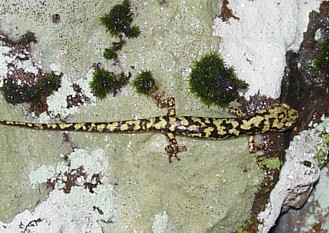
Photo ©David Withers, TDEC-DNH
GREEN SALAMANDER
Aneides aeneus
A beautiful, rarely seen salamander (8 – 14 cm), the green salamander spends much of its time on sandstone, or sometimes limestone, rock faces with many crevices, or more rarely in trees or under the loose bark of fallen timber. This salamander has a black base color with a yellowish-green, lichen-like pattern upon the back. It has a flattened body, long legs and square toe tips, all adaptations for living on cliffs. Females of this species deposit their eggs in moist crevices in the rock face and will actively protect their eggs from small predators and fungus. The range of this species is rather limited in Tennessee, being confined mainly to the Cumberland Mountain, Highland Rim and Cumberland Plateau physiographic provinces.
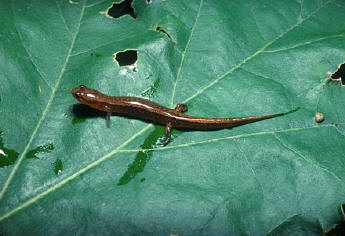
Photo ©Stephen G. Tilley
SEEPAGE SALAMANDER
Desmognathus aeneus
One of the two smallest salamanders in Tennessee (3.8 – 5.7 cm), the seepage salamander has a yellowish to reddish-brown wavy, or sometimes straight, stripe going down the back. They often have a dark “Y” behind the head and extending onto the midline of the back either in a line or series of dots; they may also have a light circular patch on the top of each thigh. Some individuals may bear a very faint herringbone pattern upon the back, similar to the pygmy salamander. These salamanders live in and around seepage areas and near streams in moist or wet leaf litter, under logs or other surface objects and in moss mats. They are found only in the southeastern corner of the state along the Tennessee – North Carolina border. The seepage salamander is listed in Tennessee as “In Need of Management.”
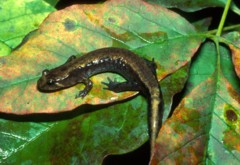
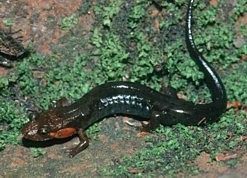
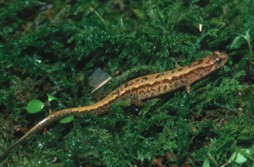
|
Photo ©Stephen G. Tilley |
Photo ©Terry Hibbitts |
Photo ©Terry Hibbitts |
Not pictured-
CUMBERLAND DUSKY SALAMANDER
Desmognathus abditus
CAROLINA MOUNTAIN DUSKY SALAMANDER
Desmognathus carolinensis
BLUE RIDGE DUSKY SALAMANDER
Desmognathus orestes
Very similar in size, shape, colors and patterns, this group of closely related salamanders can best be told apart by looking at geographic ranges or through genetic analyses by scientists. Patterning on the back may range from stripes or wavy lines to blotches. Colors may range from reds and oranges to yellows and browns. Male salamanders of all these species have well-developed jaw musculature. Adults of these species generally average between 7 and 11 centimeters. Often located near streams and seepages at lower elevations, these species may be found on the forest floor at higher elevations. These salamanders occur in limited ranges within the southern Appalachians. The Carolina mountain dusky salamander and the imitator salamander are found midway along the Tennessee - North Carolina border; the Allegheny mountain dusky salamander is found in the northern Cumberland Plateau; the Ocoee salamander is found in the southeastern corner of Tennessee in the Cumberland Plateau and Blue Ridge Mountain sections; the Cumberland Dusky Salamander is found in the middle Cumberland Plateau; and the Blue Ridge dusky salamander is found in the northeastern corner of Tennessee.
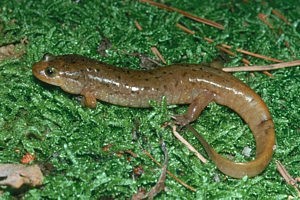
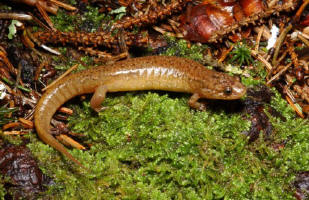
|
Photo ©Terry Hibbitts |
Photo ©Stephen G. Tilley |
Not pictured
SPOTTED DUSKY SALAMANDER
Desmognathus conanti
These three closely related dusky salamander are best distinguished by their ranges. The Santeetlah dusky is found in a small pocket of the southern Appalachians; the northern dusky is found from our eastern borders into middle Tennessee and the spotted dusky is found from middle into western Tennessee. These salamanders are generally very abundant where they occur. They are medium sized (6 – 14 cm), generally a dusky brown color, may have some spotting on the dorsum, and have a light line extending from the corner of the eye to the jaw. In the northern dusky the tail is laterally compressed and strongly keeled, whereas the tail is moderately keeled in both the spotted and Santeetlah dusky salamanders. The spotted dusky often has 6 to 8 pairs of golden to reddish spots on the dorsum and may get slightly larger (6.4 -12.7 cm) than the northern or Santeetlah dusky. The Santeetlah dusky is slightly smaller (6.4 – 9.5 cm) and has a yellowish or greenish wash upon the belly. These salamanders live in a variety of aquatic and semi-forested habitats.

Photo ©Henk Wallays
SHOVEL-NOSED SALAMANDER
Desmognathus marmoratus
The shovel-nosed salamander is a large (8-15cm), primarily aquatic species that is closely related to and resembles the black-bellied salamander. The dorsum is dark brown to black and may have two rows of irregular yellowish to grayish blotches. The belly is a dark gray with a lighter middle and can be helpful in distinguishing this species from the black-bellied. The tail is laterally compressed and strongly keeled above; the tips of the toes are dark Shovel-nosed salamanders live in cool, well-oxygenated streams at elevations of 300-1680m. They can be found along the Unaka Mountain Range in Tennessee.
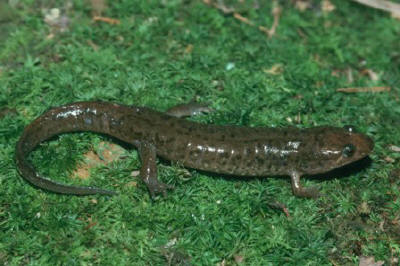
Photo ©Terry Hibbitts
SEAL SALAMANDER
Desmognathus monticola
This salamander, found in the Appalachian Mountains of East Tennessee, has a light brown to grayish dorsum that often has a darker brown reticulated or mottled pattern. The tail is round at the base but becomes triangular shaped, laterally compressed and keeled towards the end. Seal salamanders generally range from 7.5 to 15 cm in length. They prefer hardwood forests near small to medium-sized rocky streams with well-oxygenated, cool water. They are found in the mountains of the Ridge and Valley Physiographic Province and the Unaka Mountains.

Photo ©Terry Hibbitts
BLACK-BELLIED SALAMANDER
Desmognathus quadramaculatus
The black-bellied salamander is very well named as it has a solid black belly. It is a large species ranging in length from 9 to 21 cm. It has a stocky body and the tail is laterally compressed and keeled. The tips of the toes are black and cornified. The dorsum is brown to grayish-black and there is a row of yellowish dots on either side of the body. Black-bellied salamanders are mainly aquatic and live in a variety of habitats ranging from headwaters to large, fast-flowing trout streams. These salamanders are found in the mountains of East Tennessee along the Tennessee-North Carolina border.
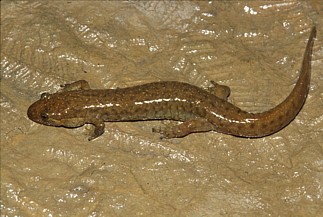
Photo ©Stephen G. Tilley
BLACK MOUNTAIN DUSKY SALAMANDER
Desmognathus welteri
A medium-sized species (7.5-17 cm), the Black Mountain Dusky salamander has a light brown dorsum with dark irregular markings. The tail is laterally compressed at the base of the tail and is strongly keeled on the top surface. They have dark, cornified toe tips and the belly is often heavily mottled. Black Mountain dusky salamanders live in moist forests along permanent, small to medium-sized streams. The Black Mountain dusky salamander is found only in the Cumberland Plateau and Cumberland Mountain physiographic provinces in Tennessee. This salamander is listed in Tennessee as “In Need of Management.”
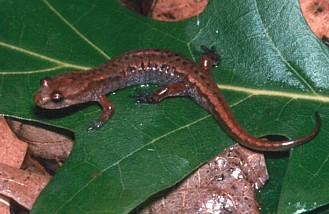
Photo ©Terry Hibbitts
PYGMY SALAMANDER
Desmognathus wrighti
The pygmy salamander is one of the smallest species of salamanders in Tennessee. Ranging from 3.7-5.1 cm long, this petite attractive species has a dark herringbone pattern on the back over a reddish-brown to coppery-colored stripe. The eyelids are usually a copper color, the belly is flesh-colored and the tail is short and round in cross-section. Pygmy salamanders live at high elevations in spruce-fir forests or in mature moist forested coves at lower elevations. They are found in the Blue Ridge Mountains along the Tennessee-North Carolina border and are listed by the state as “In Need of Management.”